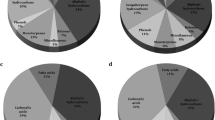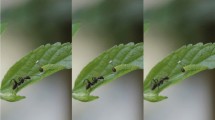Abstract
A novel in vivo design was used in combination with solid-phase microextraction (SPME) and gas chromatography/mass spectrometry (GC/MS) to characterize the volatile compounds from the skin secretion of two species of tree frogs. Conventional SPME-GC/MS also was used for the analysis of volatiles present in skin samples and for the analysis of volatiles present in the diet and terraria. In total, 40 and 37 compounds were identified in the secretion of Hypsiboas pulchellus and H. riojanus, respectively, of which, 35 were common to both species. Aliphatic aldehydes, a low molecular weight alkadiene, an aromatic alcohol, and other aromatics, ketones, a methoxy pyrazine, sulfur containing compounds, and hemiterpenes are reported here for the first time in anurans. Most of the aliphatic compounds seem to be biosynthesized by the frogs following different metabolic pathways, whereas aromatics and monoterpenes are most likely sequestered from environmental sources. The characteristic smell of the secretion of H. pulchellus described by herpetologists as skunk-like or herbaceous is explained by a complex blend of different odoriferous components. The possible role of the volatiles found in H. pulchellus and H. riojanus is discussed in the context of previous hypotheses about the biological function of volatile secretions in frogs (e.g., sex pheromones, defense secretions against predators, mosquito repellents).



Similar content being viewed by others
References
Adams RP (1995) Identification of essential oil components by gas chromatography/mass spectrometry. Allured Publishing Corporation, Carol Stream
Aldrich TB (1896) A chemical study of the secretion of the anal glands of Mephitis mephitiga (common skunk), with remarks on the physiological properties of this secretion. J Exp Med 1:323–340
Arthur CL, Pawliszyn J (1990) Solid phase microextraction with thermal desorption using fused silica optical fibers. Anal Chem 62:2145–2148
Assaf S, Hadar Y, Dosoretz CG (1995) Biosynthesis of 13-hydroperoxylinoleate, 10-oxo-8-decenoic acid and 1-octen-3-ol from linoleic acid by a mycelial-pellet homogenate of Pleurotus pulmonarius. J Agric Food Chem 43:2173–2178
Barrio A (1962) Los Hylidae de Punta Lara, Provincia de Buenos Aires. Observaciones sistemáticas, ecológicas y análisis espectrográfico del canto. Physis 23:129–142
Barrio A (1965) Las subespecies de Hyla pulchella Duméril y Bibron (Anura, Hylidae). Physis 25:115–128
Cei JM (1980) Amphibians of Argentina. Monitore Zool Ital (NS) Monogr 2:1–609
Deneris ES, Stein RA, Mead JF (1985) Acid-catalyzed formation of isoprene from a mevalonate-derived product using a rat liver cytosolic fraction. J Biol Chem 260:1382–1385
Faivovich J, Garcia PCA, Ananias F, Lanari L, Basso NG, Wheeler WC (2004) A molecular perspective on the phylogeny of the Hyla pulchella species group (Anura, Hylidae). Mol Phylogenet Evol 32:938–950
Faivovich J, Haddad CFB, Garcia PCA, Frost DR, Campbell JA, Wheeler WC (2005) Systematic review of the frog family Hylidae, with special reference to Hylinae: phylogenetic analysis and taxonomic revision. B Am Mus Nat Hist 294:1–240
Faivovich J, McDiarmid RW, Myers CW (2013) Two new species of Myersiohyla (Anura: Hylidae) from Cerro de la Neblina, Venezuela, with comments on other species of the genus. Am Mus Novit 3792:1–63
Figuérédo G, Cabassu P, Chalchat JC, Pasquier B (2006) Studies of Mediterranean oregano populations. VIII. Chemical composition of essential oils of oreganos of various origins. Flavour Fragrance J 21:134–139
Galindo-Cuspinera V, Lubran MB, Rankin SA (2002) Comparison of volatile compounds in water- and oil-soluble annatto (Bixa orellana L) extracts. J Agric Food Chem 50:2010–2015
Gallardo JM (1958) Observaciones sobre el comportamiento de algunos anfibios argentinos. Cienc Invest 14:291–302
Gallardo JM (1961) Observaciones biológicas sobre Hyla raddiana Fitz., de la provincia de Buenos Aires. Cienc Invest 17:49–96
García C, Martín A, Timón ML, Córdoba JJ (2000) Microbial populations and volatile compounds in the ‘bone taint’ spoilage of dry cured ham. Lett Appl Microbiol 30:61–66
Garcia-Estaban M, Ansorena D, Astiasaran I, Martin D, Ruiz J (2004) Comparison of simultaneous distillation extraction (SDE) and solid-phase microextraction (SPME) for the analysis of volatile compounds in dry-cured ham. J Sci Food Agric 84:1364–1370
Grafe TU, Preininger D, Sztatecsny M, Kasah R, Dehling JM, Proksch S, Hödl W (2012) Multimodal communication in a noisy environment: a case study of the Bornean rock frog Staurois parvus. PLoS ONE 7:e37965
Guilford T, Nicol C, Rothschild M, Moore BP (1987) The biological role of pyrazines: evidence for a warning odour function. Biol J Linn Soc 31:113–128
Haddadi SH, Pawliszyn J (2009) Cold fiber solid-phase microextraction device based on thermoelectric cooling of metal fiber. J Chromatogr A 1216:2783–2788
Hölldobler B (1999) Multimodal signals in ant communication. J Comp Physiol A 184:129–141
Johnson MS, Franke LS, Lee RB, Holladay SD (1999) Bioaccumulation of 2,4,6-trinitrotoluene and polychlorinated biphenyls through two routes of exposure in a terrestrial amphibian: Is the dermal route significant? Environ Toxicol Chem 18:873–878
King J, Mochalski P, Unterkofler K, Teschl G, Klieber M, Stein M, Amann A, Baumann M (2012) Breath isoprene: muscle dystrophy patients support the concept of a pool of isoprene in the periphery of the human body. Biochem Biophys Res Commun 423:526–530
Kiritsakis AK (1998) Flavor components of olive oil—a review. J Am Oil Chem Soc 75:673–681
Köhler J, Koscinski D, Padial JM, Chaparro JC, Handford P, Lougheed SC, de la Riva I (2010) Systematics of Andean gladiator frogs of the Hypsiboas pulchellus species group (Anura, Hylidae). Zool Scr 39:572–590
Larsen TO, Frisvad JC (1995) Characterization of volatile metabolites from 47 Penicillium taxa. Mycol Res 99:1153–1166
Langone JA (1994 [1995]) Ranas y sapos del Uruguay (Reconocimiento y aspectos biológicos). Mus DA Larrañaga, ser Divulgación 5: 1–123
Linzey D, Burroughs J, Hudson L, Marini M, Robertson J, Bacon J, Nagarkatti M, Nagarkatti P (2003) Role of environmental pollutants on immune functions, parasitic infections and limb malformations in marine toads and whistling frogs from Bermuda. Int J Environ Health Res 13:125–148
Merib J, Nardini G, Bianchin JN, Dias AN, Simão V, Carasek E (2013) Use of two different coating temperatures for a cold fiber headspace solid-phase microextraction system to determine the volatile profile of Brazilian medicinal herbs. J Sep Sci 36:1410–1417
Moore BP, Brown WV, Rotschild M (1990) Methylalkylpyrazines in aposematic insects, their hostplants and mimics. Chemoecology 1:43–51
Myers CW, Paolillo AO, Daly JW (1991) Discovery of a defensively malodorous and nocturnal frog in the family Dendrobatidae: phylogenetic significance of a new genus and species from the Venezuelan Andes. Am Mus Novit 3002:1–33
Musteata FM, Pawliszyn J (2007) In vivo sampling with solid phase microextraction. J Biochem Biophys Methods 70:181–193
Ouyang G, Vuckovic D, Pawliszyn J (2011) Nondestructive sampling of living systems using in vivo solid-phase microextraction. Chem Rev 111:2784–2814
Poth D, Peram PS, Vences M, Schulz S (2013) Macrolides and alcohols as scent gland constituents of the madagascan frog Mantidactylus femoralis and their instraspecific diversity. J Nat Prod 76:1548–1558
Poth D, Wollenberg KC, Vences M, Schulz S (2012) Volatiles amphibians pheromones: macrolides from mantellid frogs from Madagascar. Angew Chem Int Ed 51:2187–2190
Reynaud S, Worms IA, Veyrenc S, Portier J, Maitre A, Miaud C, Ravetton M (2012) Toxicokinetic of benzo[a]pyrene and fipronil in female green frogs (Pelophylax kl. esculentus). Environ Pollut 161:206–214
Sazima I (1974) Experimental predation on the leaf-frog Phyllomedusa rohdei by the Water Snake Liophis miliaris. J Herpetol 8:376–377
Sharkey TD (1996) Isoprene synthesis by plants and animals. Endeavour 20:74–78
Smit G, Smit BA, Engel WJM (2005) Flavour formation by lactic acid bacteria and biochemical flavour profiling of cheese products. FEMS Microbiol Rev 29:591–610
Smith BP, Hayasaka Y, Tyler MJ, Williams BD (2004a) β-caryophyllene in the skin secretion of the Australian green treefrog, Litoria caerulea: an investigation of dietary sources. Aust J Zool 52:521–530
Smith BP, Tyler MJ, Williams BD, Hayasaka Y (2003) Chemical and olfactory characterization of odorous compounds and their precursors in the parotoid gland secretion of the green tree frog, Litoria caerulea. J Chem Ecol 29:2085–2100
Smith BP, Williams CR, Tyler MJ, Williams BD (2004b) A survey of frog odorous secretions, their possible functions and phylogenetic significance. Appl Herpetol 2:47–82
Smith BP, Zini CA, Pawliszyn J, Tyler MJ, Hayasaka Y, Williams B, Caramao EB (2000) Solid-phase microextraction as a tool for studying volatile compounds in frog skin. Chem Ecol 17:215–225
Starnberger I, Poth D, Peram PS, Schulz S, Vences M, Knudsen J, Barej MF, Rödel M-O, Walzl M, Hödl W (2013) Take time to smell the frogs: vocal sac glands of reed frogs (Anura: Hyerpoliidae) contain species-specific chemical cocktails. Biol J Linn Soc 110:828–838
Starnberger I, Preininger D, Hödl W (2014) From uni- to multimodality: towards an integrative view of anuran communication. J Comp Physiol A 200:777–787
Stashenko EE, Martínez JR (2007) Sampling volatile compounds from natural products with headspace/solid-phase micro-extraction. J Biochem Biophys Methods 70:235–242
Thakeow P, Angeli S, Weissbecker B, Schutz S (2008) Antennal and behavioral responses of Cis boleti to fungal odor of Trametes gibbosa. Chem Senses 33:379–387
Tyler MJ, Stone DJM, Bowie JH (1992) A novel method for the release and collection of dermal, glandular secretions from the skin of frogs. J Pharmacol Toxicol Methods 28:199–200
Vas G, Vékey K (2004) Solid-phase microextraction: a powerful sample preparation tool prior to mass spectrometric analysis. J Mass Spectrom 39:233–254
Vasta V, Ratel J, Engel E (2007) Mass spectrometry analysis of volatile compounds in raw meat for the authentication of the feeding background of farm animals. J Agric Food Chem 55:4630–4639
Wells KD (2007) The ecology and behavior of amphibians. The University of Chicago Press, Chicago and London
Williams CR, Smith BPC, Best SM, Tyler MJ (2006) Mosquito repellents in frog skin. Biol Lett 2:242–245
Wood WF, Sollers BG, Dragoo GA, Dragoo JW (2003) Volatile components in defensive spray of the hooded skunk, Mephitis macroura. J Chem Ecol 28:1865–1870
Xu X, van Stee LLP, Williams J, Beens J, Adahchour M, Vreuls RJJ, Brinkman UAT, Lelieveld J (2003) Comprehensive two-dimensional gas chromatography (GC×GC) measurements of volatile organic compounds in the atmosphere. Atmos Chem Phys 3:665–682
Zimmermann M, Schieberle P (2000) Important odorants of sweet bell pepper powder (Capsicum annuum cv. annuum): differences between samples of Hungarian and Morrocan origin. Eur Food Res Technol 211:175–180
Acknowledgments
For helpful observations and assistance in the field we thank Patrick Colombo, Mateus Olivera, Valentina Zaffaroni, Carlos Taboada, and Boris Blotto. For their hospitality in Porto Alegre AEB thanks to Henrique Silva, Caroline Saucier, and Salua Saucier. Jorge Aznarez, Vanesa Simmão, and Mariana Lyra provided assistance in laboratory procedures. Mauricio Rivera-Correa kindly made the drawing of the in vivo sampling device. Gustavo Otati from the Facultad de Ciencias Exacts y Naturales (UBA) built the HS-SPME device for in vivo frog sampling, and Marcelo Vieira Migliorini provided useful comments to improve it. AEB thanks Benjamin Smith for valuable suggestions and encouragement during this study, and Gabriela M. Cabrera for her generous guidance during technical procedures and data analysis, and critical comments on the manuscript.. Heidi Smith-Parker, and two anonymous reviewers made useful comments on the manuscript. A scholarship support for AEB was provided by the Consejo Nacional de Investigaciones Científicas y Técnicas (CONICET). This study was undertaken under the guidelines of the Universidade Federal de Rio Grande do Sul, Universidade Federal de Santa Catarina, Universidad de Buenos Aires (UBA), and Museo Argentino de Ciencias Naturales (MACN-CONICET). AEB and JF thank ANPCyT 2007–2202, 2011–1895, 2012–2687, 2013–404, Grants 2013/50741-7 and 2013/50741-7, São Paulo Research Foundation (FAPESP), and CONICET PIP 11220110100889. JM, EC, EBC, JB and CZ thank Coordenação de Aperfeiçoamento de Pessoal de Nível Superior (CAPES) and Conselho Nacional de Pesquisa e Desenvolvimento (CNPq). EBC, JB, and CZ also thank the Fundação de Apoio a Pesquisa do Estado do Rio grande do sul (FAPERGS).
Author information
Authors and Affiliations
Corresponding authors
Rights and permissions
About this article
Cite this article
Brunetti, A.E., Merib, J., Carasek, E. et al. Frog Volatile Compounds: Application of in vivo SPME for the Characterization of the Odorous Secretions from Two Species of Hypsiboas Treefrogs. J Chem Ecol 41, 360–372 (2015). https://doi.org/10.1007/s10886-015-0564-z
Received:
Revised:
Accepted:
Published:
Issue Date:
DOI: https://doi.org/10.1007/s10886-015-0564-z




